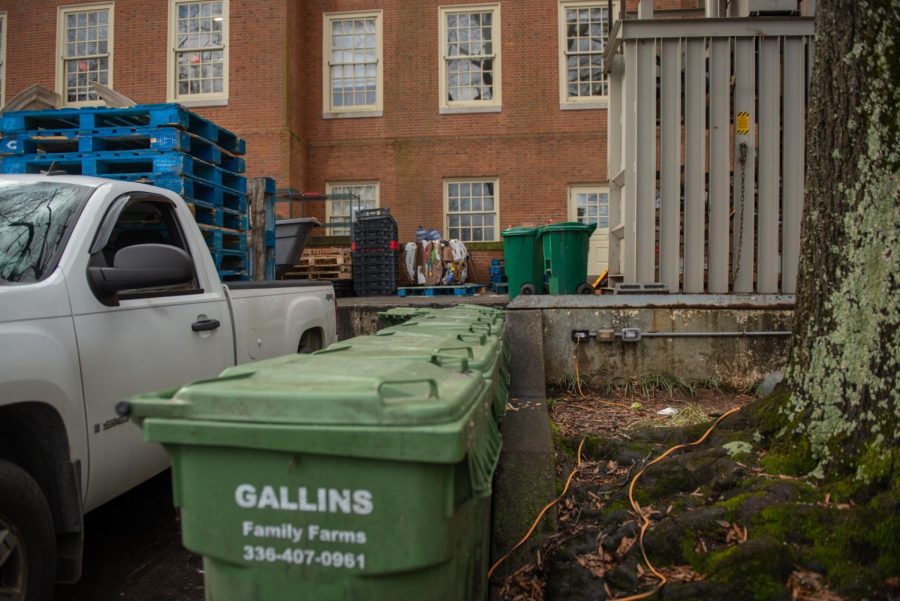Chronicling the journey of Wake Forest’s trash
The waste produced on campus may end up in many different places
Trash cans line an area behind Reynolda Hall.
January 31, 2023
When you throw away your cup at Camino or recycle cardboard in the mailroom, do you think about where that trash ends up next? The journey doesn’t end when you walk away. So what happens to trash at Wake Forest, and just how much does our campus produce? Wake Forest Waste Reduction Specialist Sophie Wimberly provides some insight into how our trash gets from campus to the landfill.
First, the trash is picked up by custodians, then consolidated to be picked up by the Waste Reduction and Recycling Team before heading to the trash compactor. The company Waste Management takes the trash to a Winston-Salem landfill.
“However, this does not apply to Camino [Bakery] because we have a front-of-house compost collection program,” Wimberly said.
Front-of-house means that it is on the consumer end. Trash produced at Camino Bakery ends up at Gallins Family Farm, a company based out of Mocksville, N.C., that takes food waste and turns it into compost for other areas of North Carolina. Front-of-house composting and organic collection also occurs at Zick’s, but the Waste Reduction and Recycling Team hopes to expand to more locations soon.
Back-of-house collection, which happens on the venue’s end, occurs at most dining locations around campus, including the Pit, all North Campus dining options and also at Zick’s in addition to front-of-house collection. North Campus Apartments have their own residence hall collection system, and Facilities and Campus Services (FCS) provides compost collection services at events and in staff lounges by request.
Recycling — split between paper, cardboard and bottles or cans — is separate from waste disposal and set up as a “multi-stream system as opposed to a single stream,” according to Wimberly.
Cardboard, specifically, is compacted and given to the companies Waste Management and Sonoco. Companies like these “recycle these items by selling them to vendors who use them for various products,” Wimberly said.
For items like bottles, cans and paper, custodians sort these into receptacles to be picked up by a waste team. They are then separated into roll-off containers for pickup by Waste Management to be delivered to a material recycling/recovery facility (MRF). Finally, the waste is sold to vendors, who again use it for new products. For example, glass waste that ends up at the Winston-Salem MRF is purchased by Strategic Materials, a company that turns it into new bottles.
Wake Forest also recycles yard waste, motor oil, tires, shredded paper, CD waste, metal, wood and books, all through various collection systems. Check out Facilities and Campus Services’ recycling page to learn more.
Wimberly reports that Wake Forest generates between 3 and 4 million pounds of trash per year on average, with 3,294,860 pounds produced in 2020. This number is the average for a school our size, but there’s always room for improvement.
There are various programs designed to reduce and redirect waste away from landfills. Deacs Donate is a student donation program that collects and manages waste produced at the end of the academic year, when students move out of residence halls. They partner with Goodwill to divert donatable items away from landfills and to people who can reuse the items.
Deacs Donate accepts items like clothing, shoes, small furniture pieces, jewelry and small appliances. Students can place these in the blue roll-off bins that can be found in first floor lobbies or by front entrances at the end of the spring semester. Larger donations like tables and couches can be placed near large-item yard signs for pick up.
According to Wimberly, Deacs Donate has collected more than 90 tons of Goodwill Donations in the past five years, receiving 7,000 pounds in the last year alone.
For electronic waste, Wake Forest’s E-waste recycling program allows community members to give unwanted or broken electronics to Facilities and Campus Services at specified drop-off locations on campus or through scheduled pick-ups. Reusable items are also donated to Goodwill and other technology is given to companies to deconstruct and reuse the parts.
Wake Forest’s textile recycling program takes clothing and fabric textiles to Green Zone, a company that recycles and repurposes them into new items to be distributed throughout the community. Kickstarted by Wimberly herself, the pilot program was implemented in November of 2020, and it has been a huge success. Green bins labeled “Textile Recovery Pilot” can be found in eight different drop-off locations on campus, including the Benson Mailroom, Polo Residence Hall and Luter Residence Hall.
Lily Miller, the Waste Reduction and Diversion Intern at the Office of Sustainability, discussed her work on expanding the textile diversion program. Miller stated that plans are in place for new bins to be put in the following residence halls: South, Collins, Babcock, Johnson, Polo, Magnolia and Dogwood, as well as Benson University Center.
Miller is also monitoring the green labs program and the glove recycling program downtown. She states that the program has “been really successful, and the labs downtown collected around 30 pounds [of glove waste] per lab last semester.”
There is also currently a program in Salem Hall, and Miller said she is trying to expand this to the biology labs and WakerSpace.
The campus Surplus Property Program collects property from departments no longer needing those items and takes them to an off-campus warehouse where other departments can use items to refurbish their offices. The program is led by Alan Winkler, the manager in Wake Forest’s Waste & Recycling department.
Winkler said that the goal of the program is to “repurpose and reuse as much furniture, supplies and equipment as possible in order to extend its useful life and keep tons of material out of the landfills.”
He added that items are donated to local charities if they are not in a condition to be used by the university.
The program has been in place since 2011. Thus far, the Surplus Property Program has redistributed more than 17,000 items to the community and more than 8,000 items to the Wake Forest departments, saving the university upwards of $3 million and diverting more than 864 tons of material from landfills.
Wake Forest’s Office of Waste Reduction and Recycling is an incredible resource for the community, and they work closely with the Office of Sustainability to consistently update and improve Wake Forest’s waste reduction and recycling initiatives.












